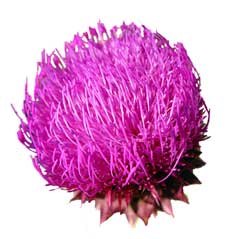Thistle oil comes from the milk thistle plant (Silybum marianum), which belongs to the basket flower family.
Thistle oil is extracted from the seeds of the milk thistle and is produced by either hot or cold pressing.
In natural medicine, thistle oil is best known for its ability to protect the liver and treat liver diseases. However, these properties are not documented.
Thistle oil is also often marketed under the name vitamin E oil because some thistle oils have a natural vitamin E content. Below you can read more about the properties of thistle oil and what it can be used for in practice.

Properties of thyme oil
Undocumented properties
Thistle oil has not been scientifically proven to treat the following health problems:
- Sun eczema
- Obesity
- Hair loss
- Irritable bowel syndrome (IBS)
- Psoriasis
- Diseases of the gallbladder
Properties studied with lack of evidence
The effects of thistle oil on the following health problems have been studied but are not considered scientifically proven:
- Liver: Thistle oil is best known for its ability to protect the liver. It is also this property for which thistle oil has long been used. The theory of its liver-protective effect stems from the high content of silibinin (also known as silybin), a derivative of silymarin, which is extracted from the seeds of the milk thistle. However, the liver-protective effect of thistle oil is not considered scientifically proven because the results of the numerous studies in the field are contradictory and there is no clear evidence of the effect yet
- Liver diseases: As with the liver-protective properties above, the studies on the effects of thistle oil and silymarin on hepatitis C and cirrhosis have produced conflicting results. Therefore, thistle oil is not considered a proven treatment option for hepatitis C or cirrhosis
- Cancer: There are several – very recent – studies on the effects of thistle oil and silymarin on cancer (including cervical cancer, prostate cancer, breast cancer and skin cancer), but the studies are generally too weak to draw firm conclusions. Therefore, thistle oil is not considered a proven treatment option for cancer
- Wound healing: There are several studies that have indicated that silymarin may be used to promote wound healing. However, the results of the studies do not prove this effect and certainly not that thistle oil can be used for wound healing
There is also no evidence that thistle oil or silymarin can be used to treat diabetes or tumors.
The use of thistle oil
Thistle oil capsules against mosquitoes
Some people use thistle oil capsules against mosquitoes (i.e. supplements containing thistle oil).
Although thistle oil has not been proven to have a deterrent effect on mosquitoes, you can try it out and see if it works.
Gastronomy
Thistle oil usually has a rich golden color, a very attractive fragrance and a nutty flavor. Its low smoke point of 109°C makes it unsuitable for hot cooking – especially for frying (virgin olive oil, for example, has a smoke point of 199°C).
Thistle oil, on the other hand, is suitable for marinades, dressings and the like. The oil's nutty flavor also makes it a good salad oil. It can also be used as a flavoring oil in hot dishes (added immediately before or upon serving) and to give cheaper oils a more distinctive aroma.
Other uses
Thistle oil is also used in:
- Baby oil
- Body lotion
- shampoo
- Massage oil
- Nutritional supplements
- Cat food
Thistle oil or safflower oil?
Safflower oil is often confused with thistle oil because the scientific classification of the Safflower and Milk Thistle species and the Thistle genus is a bit confusing. For the same reason, health food stores – and sometimes even manufacturers – mix up which is which.
The tables below show the scientific classifications for Milk Thistle, Safflower and Thistle respectively:
Milk thistle
| Rich | Plants |
| Section | Cover-seeded plants |
| Order | The basket flower order |
| The family | Basket flower family |
| Group Cynareae | Cynareae |
| Genus | Silybum |
| Species | S. marianum |
Safflower
| Kingdom | Plants |
| Department | Cover crop plants |
| Order | The basket flower order |
| The family | Basket flower family |
| Group Cynareae | Cynareae |
| Genus | Carthamus |
| Species | C. tinctorius |
Thistle
| Kingdom | Plants |
| Department | Cover-seeded plants |
| Order | The basket flower order |
| The family | Basket flower family |
| Group Cynareae | Cynareae |
| Genus | Carduus |
In English, milk thistle oil is called milk thistle oil or milk thistle seed oil, which in many ways is more correct, as the terms refer to the oil being extracted from the species milk thistle (Silybum marianum). Here, the Danish term is more imprecise because it is easy to get the impression that the oil is extracted from plants in the genus Tidsel (Carduus).
Thistle oil is also called vitamin E oil because some thistle oils naturally contain vitamin E.
Precautions to take
- Allergy: Milk thistle and thistle oil can cause allergic reactions in some cases – especially in people who are allergic to plants in the Marigold family. This is especially true for plants in theAmbrosia genus such as chrysanthemums, marigolds, daisies and others.
- Laxative effect: If consumed in larger doses – which is not recommended – thistle oil can have a laxative (laxative) effect.
